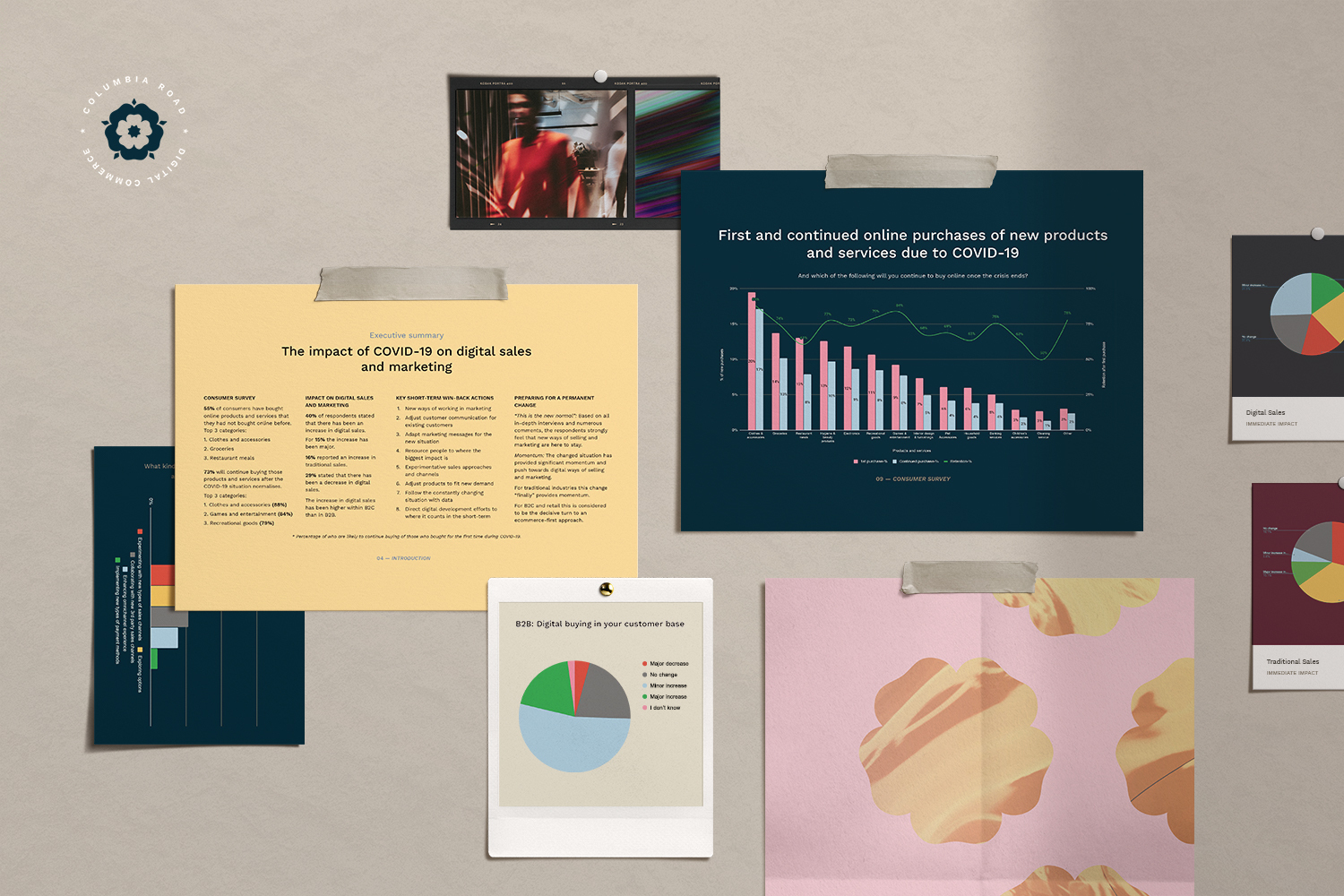The Data Handbook
How to use data to improve your customer journey and get better business outcomes in digital sales. Interviews, use cases, and deep-dives.
Get the book
The impact of COVID-19 on digital sales and marketing has been significant, and it has caused permanent changes firstly, to the ways companies will operate digital sales and marketing in the future and, secondly, to the overall digitalisation of sales processes. Regardless of the business focus or size, the respondents strongly feel that new digital ways of selling and marketing are here to stay and that the new normal needs adjusted digital sales and marketing efforts.
In order to understand the impacts of COVID-19, Columbia Road conducted a market research that consisted of a consumer survey, with over 1000 respondents, and a survey for 88 Nordic digital sales and marketing leaders, complemented by 12 in-depth interviews.
In the first part of this blog duology, we elaborated on the effects of the pandemic on consumer purchase behaviour and businesses. In this part, we will discuss the key actions to take in order to recover and to win back sales in the new business environment. What do decision makers across different industries consider to be the essential things to focus on now and in the near future? What are the key improvement and investment areas in digital sales and marketing? What actions need to be taken in order to achieve long-term success?
This blog offers an overview of the general opinion of decision makers from companies of all shapes and sizes. If you’re looking to find a wholesome bespoke digital sales solution specifically for your company, don’t hesitate to get in touch with our experts, who possess a thorough understanding on the specifics of this research and the digital sales industry.
Key short-term win-back actions – adjusting to the new normal
The interview results reveal that due to COVID-19 companies have taken rapid actions to adjust their digital sales and marketing activities, improve customer retention and win back lost customers. While 65% of respondents saw a decrease in traditional sales and 39% a decrease in digital sales, interviewees report that these rapid actions significantly diminished the negative impact of COVID-19 on their revenue.
Activities for rapid recovery in the short-term
- MARKETING WAYS-OF-WORKING: De-prioritise earlier marketing plans. Instead, due to the rapidly changing environment, run activities on a daily and weekly basis and adjust based on data and feedback.
- CUSTOMER COMMUNICATION: Seize the momentum and encourage new digital customers to stay loyal in the future. Active communication with existing customers.
- MARKETING MESSAGES: Experiment with messages that work in current situations (e.g. values, new benefits). Based on data, place your bets on those messages that seem to have a market pull.
- DEVELOPMENT: Re-focus the effort put on different customer channels based on new customer behaviour and short-term impact.
- SALES: Experiment with new lead generation and nurturing means, sales channels, services and partnerships. How to digitalise the traditional sales process?
- RESOURCING: Use resources where they are needed — help people adapt to new kinds of roles.
- PRODUCTS: Service and product adjustments based on new buying patterns.
- DATA: Investigate customer satisfaction more carefully and set clear metrics of success.
“Being flexible with changing plans - this is what corona taught us. Product placements and campaigns must be sensitive to the surrounding reality and location. It’s okay to show empathy in communication - we received positive customer feedback for sending out colouring pages in our newsletters.”
– Country Manager, Mid-sized B2B & B2C company
Three key drivers for long-term success
In order to prosper in the long-term, companies need to reconsider their investment and focus areas in digital sales and marketing. Decision-makers should be actively and constantly measuring and evaluating, whether they are focusing on the right things and whether those activities are generating the maximum value for them.
1. Agile and efficient adaptation and processes
The first, and perhaps, the most important driver for success, is agile and efficient adaptation and processes. This means that companies should be constantly following changes in the market, as well as in customer behaviour, in order to adapt and renew themselves accordingly. However, in order to efficiently adapt and gain sales and marketing process efficiencies, companies should break down silos between different phases in the sales funnel, redesign permanent and temporary roles, and change the organisational mindset. It is typical for organisation mechanisms, that the accountability of the whole sales process gets lost between functions, which causes rigid sub-optimisation. Lastly, the research revealed the need to detect new opportunities and to experiment, but also to execute them quickly when they arise.
“We have improved our marketing efficiency and reaction time by shifting into agile ways of working. This has been vital for our customer communications about changes in offered services and thus, customer satisfaction.”
– Head of Services, Large B2B & B2C company
2. New digital touchpoints and partnerships
The second driver we identified is utilising new digital touchpoints and partnerships. To be successful, companies need to identify bottlenecks in their digital capabilities and sales funnels in the current situation, and to identify new means of achieving the same outcomes. In practice, this could be experimenting with digital lead generation and optimal sequences of automated direct messaging, as well as new minimum-viable-product webshops. For instance, the Finnish railway company VR set up a simple webshop for selling and delivering meals that are normally sold for on-board train passengers in just five days.
To achieve success also in the long-term, it is essential to simplify the digital architecture and to make it as flexible as possible. Interviewees also stated that keys to long-term success can be found in agile and value-based resource allocation. For instance, one interviewee from a large retail company stated that they were able to avoid lay-offs due to their aggressive reallocation of human resources to those customer touchpoints that generated the greatest impact at the time. Lastly, interviewees saw that the significance of 3rd party collaborations will increase, especially new sales channels and API solutions were emphasised.
For B2B companies this means prioritising the replacement of face-to-face communication, and constructing an efficient digital demand generation and virtual sales cycle. Account based marketing (ABM) can be used to support current sales when new leads are difficult to obtain and face-to-face communication is scarce. For B2C companies the need and expectation for digital capabilities is higher, thus the focus should be in developing new and existing digital capabilities further.
3. Refocusing and scaling digital marketing
The third driver of success is refocusing and scaling digital marketing. During market uncertainty, cutting marketing costs might feel tempting. However, our research indicates that utilising marketing efforts to achieve a top-of-mind position now, will help with customer retention and yield dividends in the long term. Instead of cutting costs, decision makers should focus on rapid feedback and optimisation as well as data based marketing activities and prioritisation.
If sales are down, it is essential to focus on loyalty and retention. Being open and communicative about adjustments in offered products and services, as well as rewarding loyal customers with extra attention, promotions and campaigns. If sales are up, sustaining growth through loyalty and by promoting adoption in digital channels should be in the spotlight.
Get things done
In order for businesses to strive in the future, it is crucial to overview current activities in contrast to these findings, and to add action points on managers’ backlogs. Then, all that is needed is some ‘get things done’ -attitude. Although the focus change might seem drastic, the change is vital in order to stay relevant and to triumph in the long term.
Download the whole market research report to have a more in-depth understanding of the effects of COVID-19 and what digital sales & marketing leaders think to be the key things to focus on in the future.
This blog was written together with my amazing colleagues Eero Martela and Olivia Helle.
The Data Handbook
How to use data to improve your customer journey and get better business outcomes in digital sales. Interviews, use cases, and deep-dives.
Get the book




